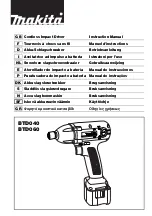
ENGLISH
6
Other types of batteries may overheat and burst
resulting in personal injury and property damage.
NOTICE:
Under certain conditions, with the charger
plugged into the power supply, the charger can
be shorted by foreign material. Foreign materials
of a conductive nature, such as, but not limited to,
grinding dust, metal chips, steel wool, aluminum
foil or any buildup of metallic particles should be
kept away from the charger cavities. Always unplug
the charger from the power supply when there is no
battery pack in the cavity. Unplug the charger before
attempting to clean.
Wireless Certifications and
Safety Information
•
This device is CAN ICES-3(B)/NMB-3(B) compliant.
•
This device complies with Part 15 of the FCC rules and
Industry Canada License-exempt RSS standard(s).
Operation is subject to the following two conditions:
This device may not cause harmful interference, and
This device must accept any interference
received, including interference that may cause
undesired operation.
This equipment has been tested and found to comply
with the limits for a Class B digital device, pursuant to Part
15 of the FCC Rules. These limits are designed to provide
reasonable protection against harmful interference in a
residential installation. This equipment generates, uses and
can radiate radio frequency energy and, if not installed and
used in accordance with the instructions, may cause harmful
interference to radio communications. However, there is no
guarantee that interference will not occur in a particular
installation. If this equipment does cause harmful interference
to radio or television reception, which can be determined by
turning the equipment off and on, the user is encouraged
to try to correct the interference by one or more of the
following measures:
Reorient or relocate the receiving antenna.
Increase the separation between the equipment
and adaptor.
Connect the equipment into an outlet on a circuit
different from that to which the adaptor is connected.
Consult the dealer or an experienced radio/TV
technician for help.
•
Changes or modifications to this equipment not expressly
approved by the manufacturer could void the user’s
authority to operate the device. This Class B digital
apparatus complies with Canadian ICES-003.
•
Under Industry Canada regulations, this radio transmitter
may only operate using an antenna of a type and
maximum (or lesser) gain approved for the transmitter by
Industry Canada. To reduce potential radio interference
to other users, the antenna type and its gain should
be so chosen that the equivalent isotropically radiated
power (e.i.r.p.) is not more than that necessary for
successful communication.
•
To comply with FCC and Industry Canada RF radiation
exposure limits for general population, the antenna used
for this device must not be co-located or operating in
conjunction with any other antenna or transmitter.
Charging a Battery (Fig. D)
1. Plug the charger into an appropriate outlet before
inserting battery pack.
MCB115
6
5
Fig. D
2. Insert the battery pack
6
into the charger, making sure
the battery pack is fully seated in the charger. The red
(charging) light will blink continuously indicating that
the charging process has started.
3. The completion of charge will be indicated by the red
light remaining ON continuously. The battery pack is
fully charged and may be used at this time or left in the
charger. To remove the battery pack from the charger,
push the battery release button
5
on the battery pack.
NOTE:
To ensure maximum performance and life of lithium-
ion battery packs, charge the battery pack fully before first
use.
Charger Operation
Refer to the indicators below for the charge status of the
battery pack.
MCB101
Charging
Fully Charged
Hot/Cold Pack Delay
Problem Pack or Charger
MCB115
Charging
Fully Charged
Hot/Cold Pack Delay*
* MCB115:
The red light will continue to blink, but a yellow
indicator light will be illuminated during this operation.
Once the battery pack has reached an appropriate
temperature, the yellow light will turn off and the charger
will resume the charging procedure.
The compatible charger(s) will not charge a faulty battery
pack. The charger will indicate faulty battery pack by
refusing to light or by displaying a problem pack or charger
blink pattern.





































